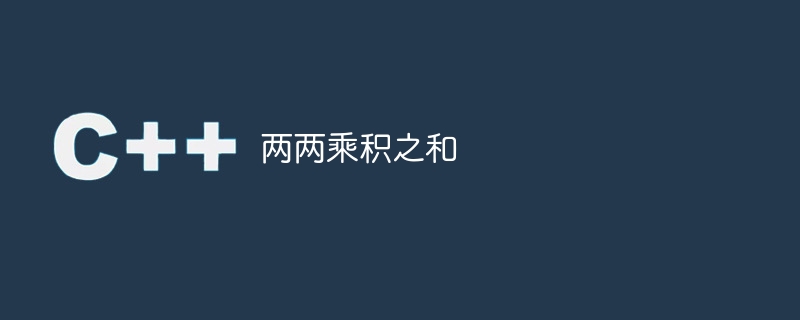

The pairwise product of the set X = {a, b, c} can be defined as the sum of the products of all possible set pairs. The pairs of sets are Y = {a * a, a * b, a *c, b * b, b * c, c * c}, where the products are commutative. Therefore, the pairwise product of a set X is the sum of the elements of the set Y, which is aa ab ac bb bc cc.
In mathematical terms, the sum of possible pairwise products can be expressed as:
$$\mathrm{\displaystyle\sum\limits_{i=1,j=i}^{i\leq n,j\leq n}\:(i,j)=i\time j}$$
Given a number n. Find the sum of pairwise products in the range (1, n), inclusive of n and 1.
Input: n = 4
Output: 65
i ranges from 1 to 4, j ranges from i to 4.
1*1 1*2 1*3 1*4 2*2 2*3 2*4 3*3 3*4 4*4 = 1 2 3 4 4 6 8 9 12 16 = 65
Input: n = 10
Output: 1705
i ranges from 1 to 10, j ranges from i to 10.
1*1 1*2 … 1*10 2*2 2*3 … 2*10 3*3 3*4 … 3*10 4*4 4 *5 … 4*10 5*5 5*6 … 5*10 6*6 6*7 … 6*10 7*7 7*8 … 7*10 8* 8 8*9 8*10 9*9 9*10 10*10 = 1705
The brute force solution to this problem is to use two for loops to iterate all possible pairs of numbers in the range, where the first loop iterates from 1 to n and the second loop iterates from the first number to n.
procedure pairwiseProduct (n) sum = 0 for i = 1 to n for j = i to n sum = sum + (i * j) end procedure
In the following program, we find all possible pairs and then find the sum of the products.
#includeusing namespace std; // Function to find pairwise product over the range 1 to n, 1 and n inclusive unsigned long long pairwiseProduct(unsigned int n){ unsigned long long sum = 0; // First number: 1 <= i <= n for (unsigned int i = 1; i <= n; i++){ // Second number: i <= j <= n for (unsigned int j = i; j <= n; j++){ sum += i * j; } } return sum; } int main(){ unsigned long long n = 9; cout << "Pairwise Product = " << pairwiseProduct(n); return 0; }
Pairwise Product = 1155
Time complexity - O(n^2)
Space complexity - O(1)
Take n = 4 as an example,
I = 1*1 1*2 1*3 1*4 2*2 2*3 2*4 3*3 3*4 4*4
In simplifying the above,
I = 1*1 (1 2)*2 (1 2 3)*3 (1 2 3 4)*4
Take prefix_sum[1] = 1,
Prefix sum[2] = 1 2,
Prefix sum[3] = 1 2 3,
Prefix sum[2] = 1 2,
procedure pairwiseProduct (n) sum = 0 prefixSum = 0 for i = 1 to n prefixSum = prefixSum + 1 sum = sum + i * prefixSum end procedure
In the program below, we find the sum of each iteration, the prefix sum, and multiply it by the number of iterations, then add to the final sum at each step.
#includeusing namespace std; // Function to find pairwise product over the range 1 to n, 1 and n inclusive unsigned long long pairwiseProduct(unsigned int n){ unsigned long long sum = 0; unsigned long long prefixSum = 0; for (unsigned int i = 1; i <= n; i++){ prefixSum += i; sum += i * prefixSum; } return sum; } int main(){ unsigned long long n = 9; cout << "Pairwise Product = " << pairwiseProduct(n); return 0; }
Pairwise Product = 1155
In short, to solve the sum of the products of pairs of numbers in the range 1 to n, we can use one of the two methods mentioned above. The first method is the brute force method, and the time complexity is O(n^ 2), the second method is an optimization method that uses prefix sum to calculate the sum of pairwise products, and the time complexity is O(n).
The above is the detailed content of The sum of the products of each pair. For more information, please follow other related articles on the PHP Chinese website!
 The eight most commonly used functions in excel
The eight most commonly used functions in excel How to create HTML project with vscode
How to create HTML project with vscode Why is the mobile phone card limited to emergency calls?
Why is the mobile phone card limited to emergency calls? What are the disk cleanup commands?
What are the disk cleanup commands? Ethereum today's market price
Ethereum today's market price How to solve the problem that document.cookie cannot be obtained
How to solve the problem that document.cookie cannot be obtained How to set font color in html
How to set font color in html what are prime numbers
what are prime numbers



